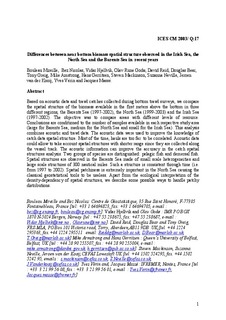Differences between near bottom biomass spatial structure observed in the Irish Sea, the North Sea and the Barents Sea in recent years
Mireille, Bouleau; Nicolas, Bez; Hjellvik, Vidar; Godø, Olav Rune; Reid, David; Beare, Douglas; Greig, Tony; Armstrong, Mike; Gerritsen, Hans D.; Mackinson, Steven; Neville, Suzanna; Kooij, Jeroen van der; Vérin, Yves; Massé, Jacques
Working paper

Åpne
Permanent lenke
http://hdl.handle.net/11250/100561Utgivelsesdato
2003Metadata
Vis full innførselSamlinger
Sammendrag
Based on acoustic data and trawl catches collected during bottom trawl surveys, we compare the spatial structure of the biomass available in the first meters above the bottom in three different regions, the Barents Sea (1997-2002), the North Sea (1999-2003) and the Irish Sea (1997-2002). The objective was to compare areas with different levels of resource. Conclusions are conditioned to the number of samples available in each respective study area (large for Barents Sea, medium for the North Sea and small for the Irish Sea). This analysis combines acoustic and trawl data. The acoustic data were used to improve the knowledge of catch data spatial structure. Most of the time, hauls are too far to be correlated. Acoustic data could allow to take account spatial structures with shorter range since they are collected along the vessel track. The acoustic information can improve the accuracy in the catch spatial structures analysis. Two groups of species are distinguished: pelagic fish and demersal fish. Spatial structures are observed in the Barents Sea made of small scale heterogeneities and large scale structures of 300 nautical miles. Such a structure is consistent through time (i.e. from 1997 to 2002). Spatial patchiness is extremely important in the North Sea causing the classical geostatistical tools to be useless. Apart from the ecological interpretation of the density-dependency of spatial structures, we describe some possible ways to handle patchy distributions.
Utgiver
ICESSerie
ICES CM documents2003/Q:17